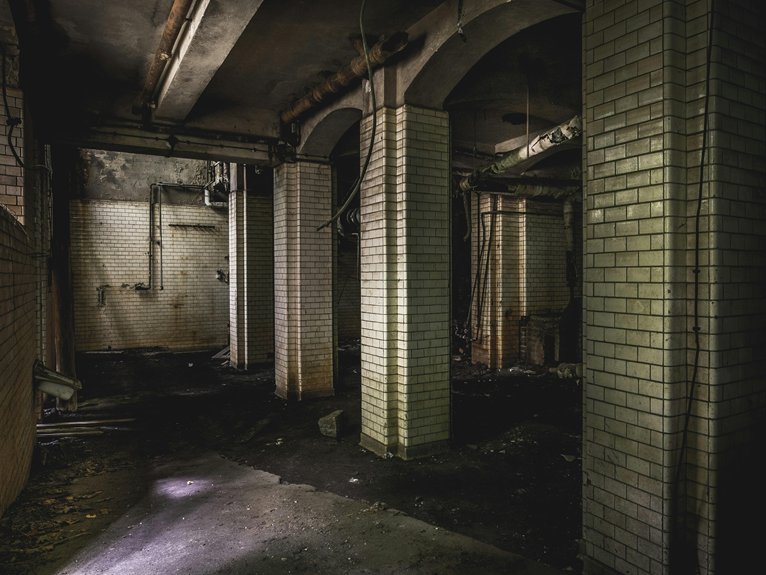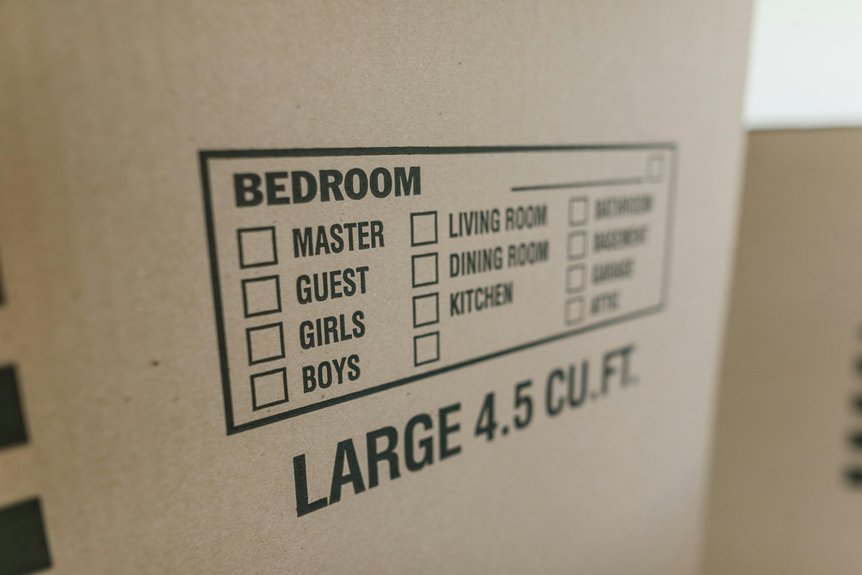When it comes to basement water issues in Jackson, identifying the source is vital. You’ll want to look for common signs like stains, mold, or musty odors. Evaluating your drainage systems and foundation is essential for effective solutions. A thorough inspection can reveal underlying problems that might not be immediately apparent. Understanding these aspects will guide you toward the right prevention and repair methods, making it easier to keep your basement dry and functional.
Key Takeaways
- Inspect for visible signs of water intrusion, such as stains, musty odors, and mold growth on walls and floors.
- Evaluate and maintain exterior drainage systems, ensuring gutters and downspouts direct water away from the foundation effectively.
- Check for cracks in basement walls and floors, as they can allow moisture to seep in and cause damage.
- Implement waterproofing solutions like interior sealants and exterior membranes to create barriers against moisture intrusion.
- Conduct regular maintenance, including seasonal inspections and cleaning gutters, to prevent water buildup and protect your basement’s integrity.
Understanding the Common Causes of Basement Water Issues
When you’re dealing with a damp basement, understanding the common causes of water issues is vital for effective resolution.
Poor drainage around your home often leads to excess water pooling near the foundation. Additionally, cracks in the walls or floor can allow moisture to seep in.
Poor drainage and cracks in walls or floors can lead to moisture seeping into your basement.
Inadequate basement waterproofing practices may fail to create effective moisture barriers, allowing humidity to penetrate.
Another factor is the high water table, which can exert pressure on your basement walls.
Identifying these causes is key for implementing the right solutions and ensuring your basement stays dry, ultimately protecting your home’s integrity and value.
Signs of Water Intrusion in Your Basement
You should look for visible water stains on walls and floors, as they often signal water intrusion.
A musty odor can also indicate moisture problems, suggesting that your basement may be harboring dampness.
Additionally, the presence of mold and mildew growth not only points to a moisture issue but can also pose health risks if left unchecked.
Visible Water Stains
Visible water stains often serve as the first alarm for potential water intrusion in your basement. These stains typically appear as dark patches or streaks on walls and floors, indicating moisture accumulation.
When you notice visible water stains, it’s essential to assess the basement humidity levels, as high humidity can exacerbate the problem. Pay attention to the color and texture of these stains; white, powdery deposits may suggest efflorescence, while dark stains often indicate mold growth.
Identifying the source of these stains early can prevent further damage and costly repairs. Regular inspections can help you maintain a dry, healthy basement environment.
Musty Odor Presence
A musty odor in your basement often signals hidden water issues that require immediate attention.
This unpleasant smell can stem from various musty smell causes, including trapped moisture, leaks, or inadequate ventilation.
To address the issue effectively, consider the following musty odor solutions:
- Identify the source of moisture and repair leaks.
- Improve ventilation by opening windows or installing vents.
- Use dehumidifiers to reduce humidity levels.
- Clean and disinfect surfaces to eliminate odor.
Ignoring this odor can lead to more significant problems, so it’s essential to take these steps to protect your home and guarantee a healthy living environment.
Mold and Mildew Growth
When moisture accumulates in your basement, it creates an ideal environment for mold and mildew to thrive, often leading to significant structural and health issues.
Look for dark spots or fuzzy patches on walls and ceilings; these are clear signs of growth. To combat this, prioritize mold prevention by ensuring proper ventilation and sealing any leaks.
Regularly inspect your basement for signs of water intrusion. If you discover mildew, act quickly with mildew treatment solutions, such as specialized cleaning products or professional remediation services.
Addressing these issues promptly can protect both your home and your health.
Inspecting Your Basement for Water Damage
To effectively inspect your basement for water damage, you need to recognize the key signs that indicate issues, such as discoloration on walls or a musty odor.
Equipping yourself with the right tools, like a moisture meter and flashlight, will enhance your inspection process.
Signs of Water Damage
Water damage can manifest in various ways within your basement, making it essential to recognize its signs early.
During your basement inspection, look for these key indicators:
- Stains on walls or ceilings, often brown or yellowish
- Mold growth, which can appear as dark spots or fuzzy patches
- Unpleasant odors, suggesting stagnant water or decay
- Peeling paint or wallpaper, indicating moisture behind surfaces
Identifying these signs promptly can save you from costly repairs and health issues.
Keep an eye out and act fast to address any water damage to keep your basement safe and dry.
Tools for Inspection
Recognizing the signs of water damage is just the beginning; having the right tools for inspection can make a significant difference in identifying the extent of the problem. A moisture meter allows you to pinpoint areas with excessive humidity, while thermal imaging reveals hidden leaks and temperature variations.
| Tool | Purpose |
|---|---|
| Moisture Meter | Measures moisture levels |
| Thermal Imaging | Detects temperature differences |
| Flashlight | Illuminates dark corners |
| Inspection Mirror | Views hard-to-reach areas |
| Camera | Documents damage visually |
These tools will equip you to tackle any water issues effectively.
Evaluating Exterior Drainage Systems
How can you guarantee that your basement stays dry when heavy rains hit? Evaluating your exterior drainage system is essential.
Start by checking:
- Gutters: Verify they funnel water away from your foundation.
- Downspouts: Confirm they extend at least 5 feet from the house.
- Landscape grading: Ensure that your yard slopes away from the home.
- French drains: Inspect for blockages or damage that could impede water flow.
A well-maintained drainage system and proper landscape grading can greatly reduce the risk of water pooling around your foundation, protecting your basement from potential flooding.
Assessing and Repairing Foundation Cracks
While ensuring your basement remains dry, it’s crucial to assess and repair any foundation cracks.
Begin by inspecting your foundation for visible cracks, noting their size and location. Small cracks may only require crack sealing, while larger ones could indicate structural issues needing professional foundation repair.
Use a concrete filler for minor cracks, ensuring it’s applied evenly. For significant damage, consult a structural engineer or foundation specialist.
Regularly monitor repaired areas to prevent future water infiltration. Addressing these cracks promptly can safeguard your home’s integrity and keep your basement dry and functional.
Importance of Proper Gutter Maintenance
After addressing foundation cracks, the next step to guaranteeing a dry basement involves proper gutter maintenance.
Regular gutter cleaning is essential to prevent clogs that can lead to overflow. When gutters overflow, water can pool around your foundation, increasing the risk of basement leaks.
Additionally, consider installing a downspout extension to direct water away from your home. This can further minimize water intrusion risks.
To maintain effective gutters, remember to:
- Clean gutters at least twice a year
- Inspect for damage or rust
- Guarantee downspouts discharge water away from the foundation
- Trim overhanging branches that could block gutters
Installing a Sump Pump for Water Management
Installing a sump pump is a proactive measure that can considerably reduce the risk of water accumulation in your basement. The sump pump benefits include preventing mold growth, protecting your home’s foundation, and enhancing property value.
For sump pump installation, start by identifying the lowest point in your basement, where water tends to collect. Dig a pit to accommodate the pump and guarantee proper drainage away from your home.
Connect the pump to a power source and test it to confirm functionality. Regular maintenance, including cleaning and checking the discharge line, guarantees ideal performance and longevity of your sump pump system.
Utilizing Waterproofing Solutions
Waterproofing solutions are essential for safeguarding your basement against moisture intrusion.
To effectively address this issue, you should consider various waterproofing materials and drainage solutions tailored to your specific needs. Implementing these strategies can help prevent water damage and enhance your basement’s durability.
- Interior sealants to block moisture
- Exterior waterproofing membranes for long-lasting protection
- French drains to redirect water away
- Sump pumps for efficient water removal
Regular Maintenance Tips to Prevent Future Issues
Maintaining your basement’s integrity is just as important as implementing waterproofing solutions. To prevent future issues, establish a routine of seasonal inspections. Check for cracks in walls, moisture accumulation, and guarantee proper drainage solutions are functioning efficiently.
Here’s a quick maintenance checklist:
| Task | Frequency | Importance |
|---|---|---|
| Inspect drainage | Quarterly | Prevents water buildup |
| Clean gutters | Biannually | Guarantees proper flow |
| Examine walls for cracks | Annually | Identifies structural issues |
Conclusion
To summarize, addressing water issues in your basement requires a proactive approach. By understanding the common causes and identifying signs of water intrusion, you can effectively inspect and evaluate your space. Don’t overlook the importance of maintaining your exterior drainage systems and repairing foundation cracks. Installing a sump pump and utilizing waterproofing solutions can further safeguard your home. Regular maintenance will guarantee you stay ahead of potential problems, protecting your basement from future water damage.




